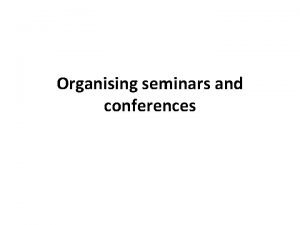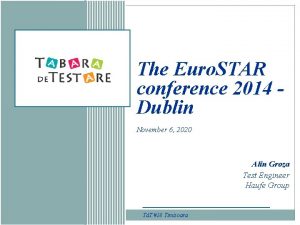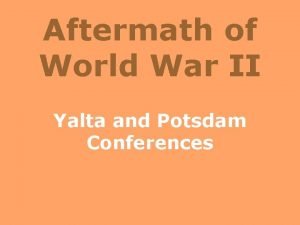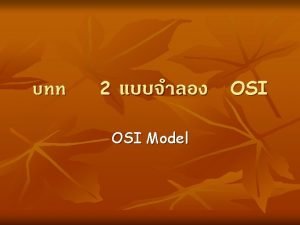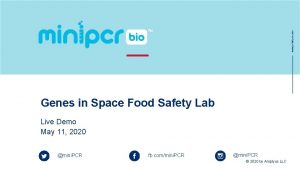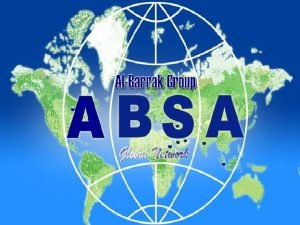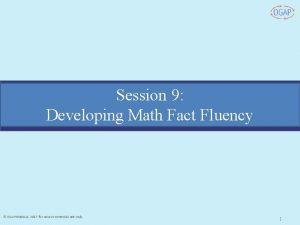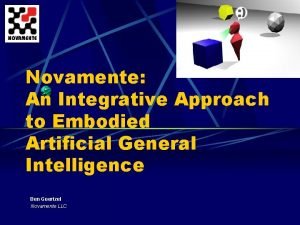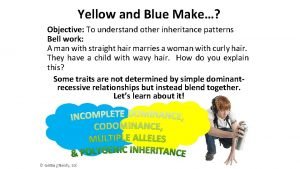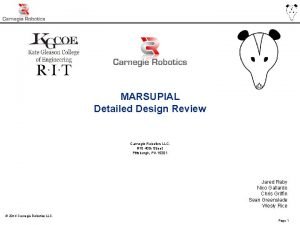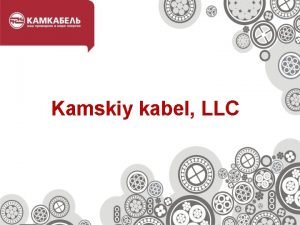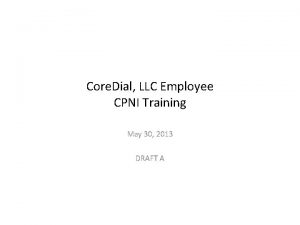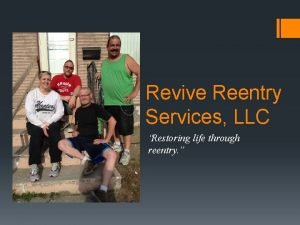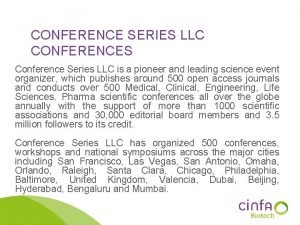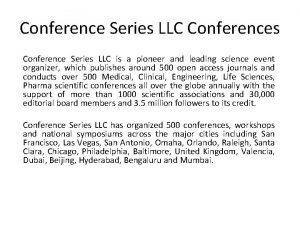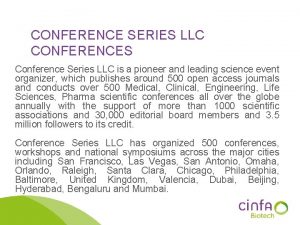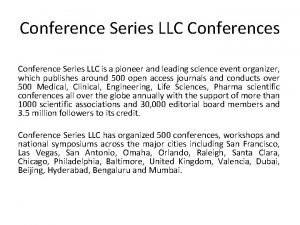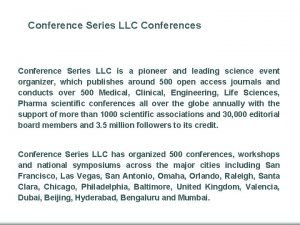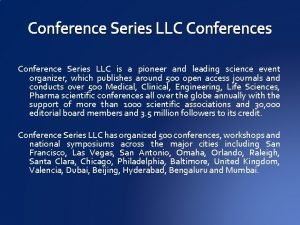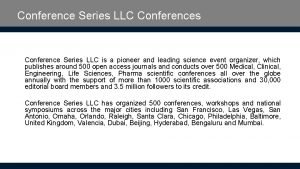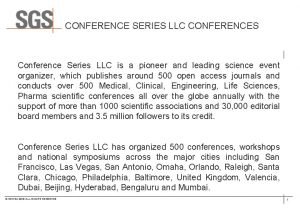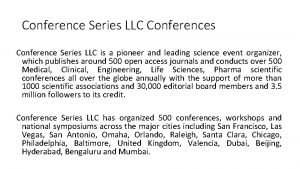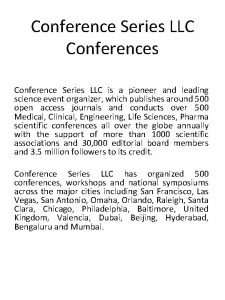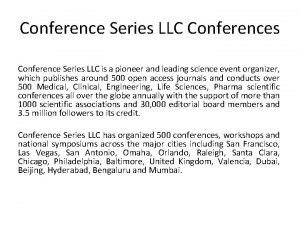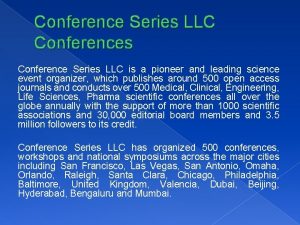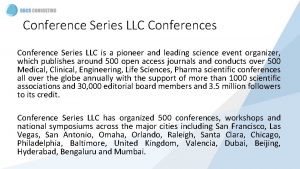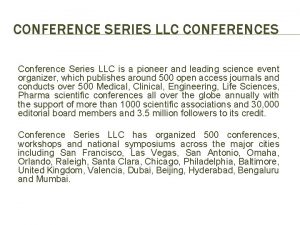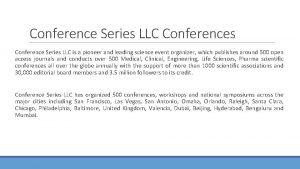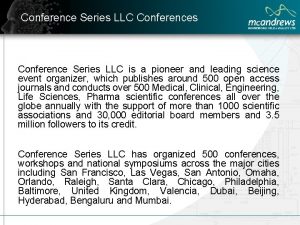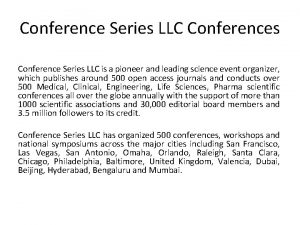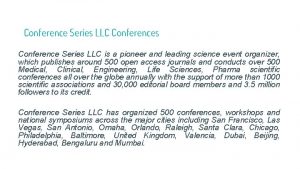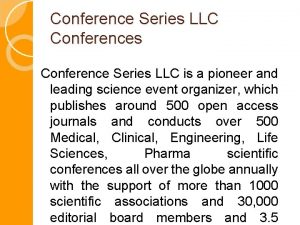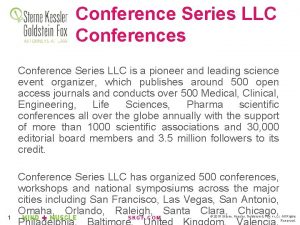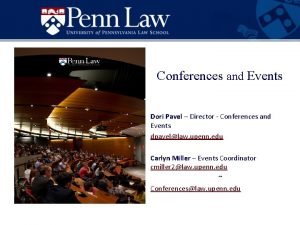CONFERENCE SERIES LLC CONFERENCES Conference Series LLC is































- Slides: 31

CONFERENCE SERIES LLC CONFERENCES Conference Series LLC is a pioneer and leading science event organizer, which publishes around 500 open access journals and conducts over 500 Medical, Clinical, Engineering, Life Sciences, Pharma scientific conferences all over the globe annually with the support of more than 1000 scientific associations and 30, 000 editorial board members and 3. 5 million followers to its credit. Conference Series LLC has organized 500 conferences, workshops and national symposiums across the major cities including San Francisco, Las Vegas, San Antonio, Omaha, Orlando, Raleigh, Santa Clara, Chicago, Philadelphia, Baltimore, United Kingdom, Valencia, Dubai, Beijing, Hyderabad, Bengaluru and Mumbai.

August 23 rd, 2016 C 1 - inhibitors (Berinert ®) versus Icatibant in the treatment of Hereditary Angioedema Dr. SILVIA LEONE, MD Post-Graduate Student – School of Clinical Toxicology and Pharmacology, Genoa, Italy Medical Doctor at A&E Dept. , «Galliera Hospital» , Genoa, Italy Cruise Chief Doctor, Governmental Official of Health on Cruises drsilvialeone@gmail. com


5 hours later

Just a few words about Angioedema Transient subcutaneous or submucosal swelling (nonpitting when pressure is applied). Histamin-mediated Angioedema – ACQUIRED Ø the most common form, often triggered by allergens (insect stings, food, drugs like: NSAIDs and ACE-Is); Ø Urticaria is common and it is mediated by mast-cells degranulation; Ø Itching is common as well; Ø It can occur quickly, usually within a hour from the exposure to the allergens. Bradykinins-mediated Angioedema HEREDITARY (HA) or ACQUIRED It is a rare genetic disorder (prevalence 1: 50, 000); the inheritance is autosomal dominant. Most cases are due to mutations in SERPING 1 gene encoding for C 1 -esterase inhibitors resulting in: ü Low plasma concentrations of C 1 -INH (HA type 1); ü Functionally impaired C 1 -INH – normal concentrations (HA type 2). * Normal C 1 -INH (concentrations and functions), but probable mutation in the gene encoding for Coagulation Factor XII (HA type 3 – not yet fully understood)

Just a few words about Angioedema Transient subcutaneous or submucosal swelling (nonpitting when pressure is applied). Bradykinins-mediated Angioedema HEREDITARY (HA) or ACQUIRED Histamin-mediated Angioedema – ACQUIRED v Urticaria and itching don’t occur Ø the most common form, often triggered v The attack usually develops over by allergens (insect stings, food, drugs like: NSAIDs and ACE-Is); Ø Uricaria is common and it is mediated by mast-cells degranulation; several hours (sometimes during the night) v Attacks tend to be more severe and Ø Itching is common as well; persistent lasting up to 7 days and Ø It can occur quickly, usually within a involving the abdomen. hour from the eposure to the allergens.

Bradykinins-mediated Angioedema HEREDITARY (HA) or ACQUIRED Associated with ACE-Is therapy: the enzyme degrades bradykinin (accumulation). Other drugs include: NSAIDs, antibiotics, angiotensin receptor blockers (ARBs) and oral antidiabetic DDP-IV inhibitors plus ACE-Is. Symptoms: • Usually localized in the face or upper aerodigestive tract, • Non-itchiness and erythema lasting 24 to 72 hours Bradykinin-mediated angioedema can also develop later in life, and is known as ACQUIRED ANGIOEDEMA. This condition is very rare (prevalence of 1: 100, 000 to 1: 500, 000). The symptoms are the same of HA. Almost all cases are diagnosed during or after the 4 th decade of life and are often associated with an underlying lymphatic disorder and/or antibodies against C 1 -INH.

Schematic representation of angioedema attack onset and duration. Histamine-mediated angioedema attacks tend to have rapid onset and resolution. Bradykinin-mediated angioedema usually develops more slowly and can persist for up to 5 days, although ACE-Is-Induced angioedema will usually resolve within 48 hours once the drug is discontinued.

Diagnosis A diagnosis of hereditary or acquired angioedema can be confirmed with blood test; however currently available blood tests cannot confirm ACE-Is-Induced Angioedema. v Low C 1 -INH concentration together with low C 1 -INH function indicate type 1 HA or acquired angioedema. v Whereas low C 1 -INH function in the presence of normal ot high C 1 -INH concentrations is diagnostic for type 2 HA. v C 4 concentrations, which are substantially reduced during an attack of HA are useful for screening, but false positive/negative results are possible. v Both C 1 -INH and C 4 concentrations are normal in patients with ACE-Is-induced angioedema. v If the attack is histamine-mediated tryptase concentrations in blood drawn within 4 to 6 hours from the onset and are indicative of anaphylaxis.

Different pathophysiology does mean Different therapies Histamine-mediated Angioedema must be treated with: anti-histamines, corticosteroids and epinephrine Whereas Bradykinin-mediated Angioedema won’t respond to corticosteroids and needs specific therapies: C 1 esterase INH : Ø Human: C 1 -INH concentrate - Berinert® [Germany: 1979; FDA: September 2009 + January 2012] and Cinryze® [FDA 2008 for HA prophylaxis] Ø Recombinant (rh. C 1 -INH): Ruconest ® [FDA 2014] Selective Bradykinin B 2 receptor antagonist: Ø Icatibant - Firazyr ® [EMEA: 2008; FDA: 2011] Plasma Kallikrein Inhibitor: Not approved in Europe !!! Ø Human: ecallantide [Kalbitor ®]

STP before a medical or surgical procedure LTP: the frequency of recurrences has an extremely high intra-subject and intersubject variability, ranging from less then once a year up to every 3 -4 days. The most common therapies are: androgens (danazol – 200 mg/daily or less), tranexamic acid, C 1 -INH nano-filtered (Cinryze®)

C 1 -INH is a member of the serpin family of protease inhibitors, as are alpha-antitrypsin, anti-thrombin III, and angiotensinogen. Synthesized primarily by hepatocytes, C 1 INH is also synthesized by monocytes. The regulation of the protein production is not completely understood but, since patients respond clinically to androgen therapy and demonstrate increased serum levels of C 1 -INH, it is believed that androgens may stimulate C 1 -INH synthesis. C 1 -INH also inhibits components of the fibrinolytic, clotting, and kinin pathways. Specifically, C 1 -INH inactivates plasmin-activated Hageman factor (factor XII), activated factor XI, plasma thromboplastin antecedent (PTA), and kallikrein. Within the complement system, C 1 -INH blocks the activation of C 1 and the rest of the classic complement pathway by binding to C 1 r and C 1 s. Without C 1 -INH, unchecked activation of C 1, C 2, and C 4 occur before other inhibitors (C 4 -binding protein and factors H and I) can halt the cascade. Evidence is now overwhelming that bradykinin is the mediator responsible for capillary leakage. Bradykinin is an important inflammatory mediator that causes neutrophil chemotaxis, capillary dilation with plasma leakage, and smooth muscle relaxation, and it has been linked to other forms of angioedema.

Let’s focus on BERINERT® and Icatibant (FIRAZYR®)… WHY? ØTwo different mechanisms of action Ø «oldest» molecules, more clinical trials, more knowledge : PHARMACOVIGILANCE !!!! ØMost used in Italy ØMy Personal Experience in the A&E Dept. «Galliera Hospital» , Genoa, Italy

• Highly purified, freeze dried C 1 esterase INH concentrate derived from human plasma. • PK investigated in in an open-label, uncontrolled, single-centre study in 40 subjects, (6 patients < 18 years) with either mild or severe HA. 25 subjects were treated on demand for an acute attack 15 subjects were treated on a prophylactic basis. Dosage: single IV injection ranging from 500 to 1500 IU. Median Recovery: 86. 7% for children: 98. 2% vs. 82. 5% for severe attacks was higher than for mild attacks. Median Increase of C 1 est-INH activity was 2. 3%/IU/kg body weight with a maximum concentration within 0. 8 hours after administration. • Clinical Trials about efficacy and safety: I. M. P. A. C. T. 1 a pivotal phase III RCT: prospective, multinational, randomized, parallel-group, controlled, dose-finding, three-arm, double-blind. placebo- I. M. P. A. C. T. 2 another prospective, open-label, uncontrolled, multicenter extension study in subject who had participated in the pivotal phase III study and experienced a life-threatening laryngeal attack prior to enrolment (in this trial attacks at any body location were treated).

I. M. P. A. C. T. 1 It assessed the efficacy and safety of Berinert in 124 adult and pediatric subjects with C 1 esterase inhibitor deficiency who were experiencing an acute moderate to severe attack of abdominal or facial HAE. Subjects ranged in age from six to 72 years of age; 67. 7% were female and 32. 3% were male; and approximately 90% were Caucasian. The study objectives were to evaluate whether Berinert shortens the time to onset of relief of symptoms of an abdominal or facial attack compared to placebo and to compare the efficacy of two different doses of Berinert. Subjects were randomized to receive a single 10 IU/kg body weight dose of Berinert (39 subjects), a single 20 IU/kg dose of Berinert (43 subjects), or a single dose of placebo (42 subjects) by slow intravenous infusion (recommended to be given at a rate of approximately 4 m. L per minute) within 5 hours of an HAE attack. At least 70% of the subjects in each treatment group were required to be experiencing an abdominal attack. If a subject experienced no relief or insufficient relief of symptoms by 4 hours after infusion, investigators had the option to administer a second infusion of Berinert (20 IU/ kg for the placebo group, 10 IU/kg for the 10 IU/kg group), or placebo (for the 20 IU/kg group). This masked (blinded) “rescue study medication” was administered to subjects and they were then followed until complete resolution of symptoms was achieved. Adverse events were collected for up to 7 to 9 days following the initial administration of Berinert or placebo. In the rare case that a subject developed life-threatening laryngeal edema after inclusion into the study, immediate start of open-label treatment with a 20 IU/kg body weight dose of Berinert® was allowed. All subjects who received confounding medication (rescue medication) before symptom relief were regarded as “non-responders. ”

I. M. P. A. C. T. 2 Berinert was evaluated in a prospective, open-label, uncontrolled, multicenter extension study conducted at 15 centers in the US and Canada in subjects who had participated in the RCT study for the treatment of acute abdominal or facial attacks in subjects with hereditary angioedema. The purpose of this extension study was to provide Berinert to subjects who had participated in the RCT study and who experienced any type of subsequent HAE attack (i. e. , abdominal, facial, peripheral, or laryngeal). The safety analysis of the open-label extension study included a total of 57 subjects (19 males and 38 females, age range: 10 to 53 years) with 1085 HAE attacks treated with 20 IU/kg body weight dose of Berinert per attack, who were observed at the study site until onset of relief of HAE symptoms, and were followed up for adverse reactions for 7 to 9 days following treatment of each HAE attack. During the extension study, 51 subjects experienced 747 abdominal attacks, 21 subjects experienced 51 facial attacks, 30 subjects experienced 235 peripheral attacks, and 16 subjects experienced 48 laryngeal attacks. Some study subjects may have experienced HAE attacks in more than one location. An analysis of laryngeal HAE attacks showed that the median time to initial onset of symptom relief and median time to complete resolution in the per-attack analysis were 0. 25 hours and 8. 4 hours, respectively, which were the shortest times among the various attack locations.


AEs reported in the RCT I. M. P. A. C. T. 1 in patients receiving Berinert® 20 UI/kg : - NAUSEA (7%) - HEADACHE (7%) - ABDOMINAL PAIN (7%) - DYSGEUSIA (4. 7%) - VOMITING (2. 3%) No AEs or Serious AEs (SEAs) leading to discontinuation occurred within 4 hours after study treatment. Subjects were tested at baseline and after 3 months for possible exposure to Parvovirus B 19, hepatitis B, hepatitis C, and HIV-1 and HIV-2. No subject who underwent testing evidenced seroconversion or treatment-emergent positive polymerase chain reaction testing for these pathogens. In I. M. P. A. C. T. 2 AEs possibly related to treatment were reported in 8/57 (14%) patients. One patient discontinued the treatment due to an infusion-related reaction.

Since 1985 approximately 30, 000 patients per year were treated with Berinert®. The most important identified and potential risks are: hypersensitivity reactions, thromboembolic events and the risk of transmission of infectious agents. Adverse reactions reported in Europe since 1979 in patients receiving Berinert® for treatment of HA include: hypersensitivity/anaphylactic reactions, injection-site pain, injection-site redness, chills, and fever. v Plasma-derived products need continuous surveillance for their infectivity potential, but no case of blood-borne infection has been reported for pd-C 1 -INHs currently available for HA since their presence on the market. v Serious arterial and venous thromboembolic (TE) events have been reported at the recommended dose of Berinert®, following administration in patients with HA. Risk factors may include the presence of an indwelling venous catheter/access device, prior history of thrombosis, underlying atherosclerosis, use of oral contraceptives or certain androgens, morbid obesity, and immobility. Benefits of treatment of HAE attacks should be weighed against the risks of TE events in patients with underlying risk factors. Monitor patients with known risk factors for TE events during and after Berinert administration. TE events have also been reported following administration at higher than recommended doses. It was concluded that pd. C 1 -INH (Berinert®) has a favorable safety profile, which is in agreement with numerous observational studies conducted.

Icatibant - Firazyr® • Icatibant (Firazyr®), a synthetic, synthetic selective BK-B 2 r antagonist (inhibits bradykinin from binding the B 2 receptor and thereby treats the clinical symptoms of an acute, episodic attack of HA), has been available in Italy since 2009 as prefilled syringes containing 30 mg of drug to be self-injected subcutaneously for treatment of acute attacks in adult patients. • The recommended dose of FIRAZYR® is 30 mg administered by subcutaneous (SC) injection in the abdominal area. Additional doses may be administered at intervals of at least 6 hours if response is inadequate or if symptoms recur. No more than 3 doses may be administered in any 24 hour period. • PK bioavailability of 97% mean half-life of 1. 4 ± 0. 4 hours metabolized by proteolytic enzymes to inactive metabolites excreted in the urine (no interference with CYP) • Clinical Trials about efficacy and safety: Two parallel phase III studies, FAST-1 (in the United States) and FAST-2 (in Europe and Israel), acute HA attacks. As the endpoint was initially reached just in FAST-2, Icatibant was licensed in starting from 2008. Europe Another similar trial, FAST-3 showing Icatibant to be significantly superior to placebo was necessary FDA approval given in 2011. for

KNOWN ADVERSE EVENTS üInjection site reactions are reported in most patients after administration. Other adverse reactions reported include pyrexia, increase in transaminases, dizziness, and rash, tiredness, drowsiness, and dizziness üThe B 2 receptor has been implicated in the cardio-protective effects of bradykinin and antagonism of this receptor could potentially have negative cardiovascular effects It should be used during acute coronary ischemia, unstable angina pectoris, or in the weeks following a stroke only if the benefit exceeds theoretical risk to the patient.

The primary endpoint in all three FAST trials was assessed using a threepoint visual analogue scale (VAS) assessment of symptoms – skin swelling, skin pain and abdominal pain.

Berinert® Firazyr® Treatment of acute abdominal, facial, or laryngeal attacks of hereditary angioedema (HAE) in adult and children. Treatment of acute attacks of HA in adults. It may also be used in suspected case of ACE-Is AE. It can be considered for empiric use when the cause is unknown Store the vial in the original carton in order to protect from light. Store at 2 -25°C. 500 units lyophilized concentrate in a single-use vial for reconstitution with 10 m. L of diluent (sterile water). Prefilled syringes containing 30 mg of drug. Store at 2 -25 °C. It doesn’t need a refrigerator. ADMINISTRATION Administer 20 units per kg body weight I. V. at a rate of 4 ml/minute. Self-administration not advised. Self-injection subcutaneously in the abdominal area PREGNANCY Limited human data. Use only if clearly needed. Pregnancy Category C. CHILDREN Compared to adults, when adjusted for baseline, the half-life was shorter and clearance (on per kg basis) was faster in children. Safety and effectiveness below the age of 18 years have not been established yet. HALF-LIFE 18. 4 ± 3. 5 hours (until 87 hours for Berinert® 1500 UI) 1. 4 ± 0. 4 hours CONTRAINDICATIONS Contraindicated in individuals with a history of life-threatening systemic reactions to C 1 esterase inhibitor preparations (including anaphylaxis). TE events: Risk factors may include having an indwelling venous catheter/access device; prior history of thrombosis; underlying atherosclerosis; use of oral contraceptives or certain androgens; morbid obesity; and immobility It should be used during acute coronary ischemia, unstable angina pectoris, or in the weeks following a stroke only if the benefit exceeds theoretical risk to the patient. TIME TO ONSET OF RELIEF/RESOLUTION Time to onset of relief from ABDOMINAL symptoms: median of 48 minutes, while time to onset of LARYNGEAL symptoms: 0. 25 mins. Time to resolution: 8. 4 hours Median time to 50% reduction from baseline symptoms ranging from 2. 0 to 2. 3 hours. INDICATIONS DOSAGE, STORAGE, DOSAGE FORM

In Italy: Berinert®: the commercialized box contains 50 UI. The recommended posology (20 UI/Kg) for a patients of about 70 kg (3 boxes) costs 1, 680 € (exfactory). Icatibant: the cost of a single dose is 1529, 75 € (exfactory), but often we should use more than one box….

My Experience at A&E Dept. «GALLIERA Hospital» , Genoa, Italy All cases of hereditary angioedema were registered for a period of 1 year (2015) in the Emergency Dept. of “Galliera Hospital” (Genoa, Italy), using a Program called ‘PIESSE’. We observed a total of 39 cases of angioedema. 11 of them were bradykinin-mediated. We are glad to point out that all the hereditary angioedema were recognized immediately by the Medical Doctors due to a particular awareness of this kind of disease. 6 cases were treated with Icatibant, and 5 with C 1 -inhibitors (Berinert ®). We use both drugs, but in the A&E Dept. , we usually prefer Icatibant: Possibility to use it also in case of ACE-Is angioedema and in unknown causes angioedema (empiric use). Ø Usually quick response Ø Short half-life AND Ø No need of refrigeration Ø Subcutaneous Injection [Christian Longley, Icatibant and its therapeutic indications, Critical Care Horizon 2016; 2: 1 -11]

My Experience at A&E Dept. «GALLIERA Hospital» , Genoa, Italy This is a case treated with Icatibant: 1 hour later Arrival at A&E At Icatibant injection 3 hours later

5 hours later

References: Bernstein JA, Moellman J. Emerging concepts in the diagnosis and treatment of patients with undifferentiated angioedema. Int J Emerg Med. 2012; 5(1): 39. Kelly M, Donnelly JP, Mc. Annally JR, Wang HE. National estimates of emergency department visits for angioedema and allergic reactions in the United States. Allergy Asthma Proc. 2013; 34(2): 150 -154. Bernstein JA. HAE update: epidemiology and burden of disease. Allergy Asthma Proc. 2013; 34(1): 3 -6. Lombardi C, Crivellaro M, Dama A, Senna G, Gargioni S, Passalacqua G. Are physicians aware of the side effects of angiotensin-converting enzyme inhibitors? : a questionnaire survey in different medical categories. Chest. 2005; 128(2): 976 -979. Jaiganesh T, Hughan C, Webster A, Bethune C. Hereditary angioedema: a survey of UK emergency departments and recommendations for management. Eur J Emerg Med. 2012; 19(4): 271 -274. Brown NJ, Snowden M, Griffin MR. Recurrent angiotensin-converting enzyme inhibitor--associated angioedema. JAMA. 1997; 278(3): 232 -233. Roberts DS, Mahoney EJ, Hutchinson CT, Aliphas A, Grundfast KM. Analysis of recurrent angiotensin converting enzyme inhibitor-induced angioedema. Laryngoscope. 2008; 118(12): 2115 -2120. Jaiganesh T, Wiese M, Hollingsworth J, Hughan C, Kamara M, Wood P et al. Acute angioedema: recognition and management in the emergency department. Eur J Emerg Med. 2013; 20(1): 10 -17. Burton OT, Oettgen HC. Beyond immediate hypersensitivity: evolving roles for Ig. E antibodies in immune homeostasis and allergic diseases. Immunol Rev. 2011; 242(1): 128 -143. Kaplan AP, Joseph K, Silverberg M. Pathways for bradykinin formation and inflammatory disease. J Allergy Clin Immunol. 2002; 109(2): 195 -209. Zuraw B, Banerji A, Bernstein JA, Busse PJ, Christiansen SC, Davis-Lorton M et al. US Hereditary Angioedema Association Medical Advisory Board 2013 Recommendations for the Management of Hereditary Angioedema Due to C 1 Inhibitor Deficiency. J Allergy Clin Immunol Pract. 2013; 1(5): 458 -467. Dewald G, Bork K. Missense mutations in the coagulation factor XII (Hageman factor) gene in hereditary angioedema with normal C 1 inhibitor. Biochem Biophys Res Commun. 2006; 343(4): 1286 -1289. Cicardi M, Zanichelli A. Acquired angioedema. Allergy Asthma Clin Immunol. 2010; 6(1): 14. Bertazzoni G, Spina MT, Scarpellini MG, Buccelletti F, De SM, Gregori M et al. Drug-induced angioedema: experience of Italian emergency departments. Intern Emerg Med. 2013. Toh S, Reichman ME, Houstoun M, Ross SM, Ding X, Hernandez AF et al. Comparative risk for angioedema associated with the use of drugs that target the renin-angiotensin-aldosterone system. Arch Intern Med. 2012; 172(20): 15821589. Grouzmann E, Livio F, Buclin T. Angiotensin-converting enzyme and dipeptidyl peptidase IV inhibitors: an increased risk of angioedema. Hypertension. 2009; 54(3): 468 -470. Cicardi M, Bergamaschini L, Zingale LC, Gioffre D, Agostoni A. Idiopathic non-histaminergic angioedema. Am J Med. 1999; 106(6): 650 -654. Moellman JJ, Bernstein JA, Lindsell C, Banerji A, Busse PJ, Camargo CA, Jr. et al. A consensus parameter for the evaluation and management of angioedema in the emergency department. Acad Emerg Med. 2014; 21(4): 469 -484. Zilberberg MD, Jacobsen T, Tillotson G. The burden of hospitalizations and emergency department visits with hereditary angioedema and angioedema in the United States, 2007. Allergy Asthma Proc. 2010; 31(6): 511 -519. Zilberberg MD, Nathanson BH, Jacobsen T, Tillotson G. Descriptive epidemiology of hereditary angioedema emergency department visits in the United States, 2006 -2007. Allergy Asthma Proc. 2011; 32(5): 390 -394. Felder S, Curtis RM, Ball I, Borici-Mazi R. Prognostic factors in outcome of angioedema in the emergency department. Allergy Asthma Proc. 2014; 35(5): 362 -370. Jolles S, Williams P, Carne E, Mian H, Huissoon A, Wong G et al. A UK national audit of hereditary and acquired angioedema. Clin Exp Immunol. 2014; 175(1): 59 -67. Brown NJ, Ray WA, Snowden M, Griffin MR. Black Americans have an increased rate of angiotensin converting enzyme inhibitor-associated angioedema. Clin Pharmacol Ther. 1996; 60(1): 8 -13. Miller DR, Oliveria SA, Berlowitz DR, Fincke BG, Stang P, Lillienfeld DE. Angioedema incidence in US veterans initiating angiotensin-converting enzyme inhibitors. Hypertension. 2008; 51(6): 1624 -1630. Malde B, Regalado J, Greenberger PA. Investigation of angioedema associated with the use of angiotensin-converting enzyme inhibitors and angiotensin receptor blockers. Ann Allergy Asthma Immunol. 2007; 98(1): 57 -63. Banerji A, Clark S, Blanda M, Lo. Vecchio F, Snyder B, Camargo CA, Jr. Multicenter study of patients with angiotensin-converting enzyme inhibitor-induced angioedema who present to the emergency department. Ann Allergy Asthma Immunol. 2008; 100(4): 327 -332. Bluestein HM, Hoover TA, Banerji AS, Camargo CA, Jr. , Reshef A, Herscu P. Angiotensin-converting enzyme inhibitor-induced angioedema in a community hospital emergency department. Ann Allergy Asthma Immunol. 2009; 103(6): 502507. Gang C, Lindsell CJ, Moellman J, Sublett W, Hart K, Collins S et al. Factors associated with hospitalization of patients with angiotensin-converting enzyme inhibitor-induced angioedema. Allergy Asthma Proc. 2013; 34(3): 267 -273.

Holm JP, Ovesen T. Increasing rate of angiotensin-converting enzyme inhibitor-related upper airway angioedema. Dan Med J. 2012; 59(6): A 4449. Williams-Johnson JA, Hemmings S, Williams EW, Channer G, Mc. Donald AH. Six years experience of angioedema at the University Hospital of the West Indies. West Indian Med J. 2007; 56(3): 278 -281. Lin RY, Shah SN. Increasing hospitalizations due to angioedema in the United States. Ann Allergy Asthma Immunol. 2008; 101(2): 185 -192. Lin RY, Levine RJ, Lin H. Adverse drug effects and angioedema hospitalizations in the United States from 2000 to 2009. Allergy Asthma Proc. 2013; 34(1): 65 -71. Bork K, Hardt J, Witzke G. Fatal laryngeal attacks and mortality in hereditary angioedema due to C 1 -INH deficiency. J Allergy Clin Immunol. 2012; 130(3): 692 -697. Benson BC, Smith C, Laczek JT. Angiotensin converting enzyme inhibitor-induced gastrointestinal angioedema: a case series and literature review. J Clin Gastroenterol. 2013; 47(10): 844 -849. Craig T, Aygören-Pürsün E, Bork K, Bowen T, Boysen H, Farkas H et al. WAO guideline for the management of hereditary angioedema. World Allergy Organ J. 2012; 5(12): 182 -199. Lang DM, Aberer W, Bernstein JA, Chng HH, Grumach AS, Hide M et al. International consensus on hereditary and acquired angioedema. Ann Allergy Asthma Immunol. 2012; 109(6): 395 -402. Ishoo E, Shah UK, Grillone GA, Stram JR, Fuleihan NS. Predicting airway risk in angioedema: staging system based on presentation. Otolaryngol Head Neck Surg. 1999; 121(3): 263 -268. Beltrami L, Zanichelli A, Zingale L, Vacchini R, Carugo S, Cicardi M. Long-term follow-up of 111 patients with angiotensin-converting enzyme inhibitor-related angioedema. J Hypertens. 2011; 29(11): 2273 -2277. Jalaj S, Scolapio JS. Gastrointestinal manifestations, diagnosis, and management of hereditary angioedema. J Clin Gastroenterol. 2013; 47(10): 817 -823. Agostoni A, Cicardi M. Hereditary and acquired C 1 -inhibitor deficiency: biological and clinical characteristics in 235 patients. Medicine (Baltimore). 1992; 71206 -215. de Graaff LC, van EM, Schipper EM, Boom H, Duschek EJ. Unnecessary surgery for acute abdomen secondary to angiotensin-converting enzyme inhibitor use. Am J Emerg Med. 2012; 30(8): 1607 -1612. Bork K, Staubach P, Eckardt AJ, Hardt J. Symptoms, course, and complications of abdominal attacks in hereditary angioedema due to C 1 inhibitor deficiency. Am J Gastroenterol. 2006; 101(3): 619 -627. Cicardi M, Bork K, Caballero T, Craig T, Li HH, Longhurst H et al. Evidence-based recommendations for therapeutic management of angioedema owing to hereditary C 1 inhibitor deficiency: consensus report of an International Working Group. Allergy. 2012; 67(2): 147 -157. Nosbaum A, Bouillet L, Floccard B, Javaud N, Launay D, Boccon-Gibod I et al. [Management of angiotensin-converting enzyme inhibitor-related angioedema: recommendations from the French National Center for Angioedema]. Rev Med Interne. 2013; 34(4): 209 -213. Bas M, Greve J, Bier H, Knopf A, Stark T, Schuler P et al. [Emergency management of acute angioedema]. Dtsch Med Wochenschr. 2010; 135(20): 1027 -1031. Cicardi M, Bellis P, Bertazzoni G, Cancian M, Chiesa M, Cremonesi P et al. Guidance for diagnosis and treatment of acute angioedema in the emergency department: consensus statement by a panel of Italian experts. Intern Emerg Med. 2014; 9(1): 85 -92. Caballero T, Baeza ML, Cabanas R, Campos A, Cimbollek S, Gomez-Traseira C et al. Consensus statement on the diagnosis, management, and treatment of angioedema mediated by bradykinin. Part I. Classification, epidemiology, pathophysiology, genetics, clinical symptoms, and diagnosis. J Investig Allergol Clin Immunol. 2011; 21(5): 333 -347. Caballero T, Baeza ML, Cabanas R, Campos A, Cimbollek S, Gomez-Traseira C et al. Consensus statement on the diagnosis, management, and treatment of angioedema mediated by bradykinin. Part II. Treatment, follow-up, and special situations. J Investig Allergol Clin Immunol. 2011; 21(6): 422 -441. Longley C. Icatibant and its Therapeutic Indications. Critical Care Horizons, 2016; 2: 1 -11 Costantino G, Casazza G, Bossi I, Duca P, Cicardi M. Long-term prophylaxis in hereditary angioedema: a systematic review. BMJ Open. 2012; 2: e 000524.

Thank you for you kind attention ! Do you have any questions? What is your experience? What do you think about? Honored to be here. Dr. Silvia Leone, MD - drsilvialeone@gmail. com

LET US MEET AGAIN. . We welcome you to our future conferences of Conference Series LLC through 9 th International Conference and Exhibition on Pharmacovigilance July 17 -19, 2017 Munich, Germany http: //pharmacovigilance. pharmaceuticalconferences. com/
 Three round table conference
Three round table conference Organizing seminars and conferences
Organizing seminars and conferences Star conferences inc
Star conferences inc As a result of the yalta and potsdam conferences, ________.
As a result of the yalta and potsdam conferences, ________. Meetings incentives conferences and exhibitions (mice)
Meetings incentives conferences and exhibitions (mice) Heisenberg 1925 paper
Heisenberg 1925 paper Shunt-series feedback amplifier
Shunt-series feedback amplifier Taylor series of composite functions
Taylor series of composite functions Series aiding and series opposing
Series aiding and series opposing Taylor series lesson
Taylor series lesson Arithmetic series formula
Arithmetic series formula Maclaurin series vs taylor series
Maclaurin series vs taylor series Ibm p series vs i series
Ibm p series vs i series Slt 800 solar light tower
Slt 800 solar light tower Characteristics of llc sublayer
Characteristics of llc sublayer Amplyus llc
Amplyus llc Hidden pivots llc
Hidden pivots llc Solar dynamics llc
Solar dynamics llc Dedicated defined benefit services
Dedicated defined benefit services The company brief
The company brief New age company llc
New age company llc Al barrak shipping agencies jeddah
Al barrak shipping agencies jeddah Customer experience solutions llc
Customer experience solutions llc Ogap math llc
Ogap math llc Novamente llc
Novamente llc Getting nerdy llc answer key
Getting nerdy llc answer key Carnegie robotics llc
Carnegie robotics llc Ee capital management
Ee capital management Kamskiy kabel, llc
Kamskiy kabel, llc Cpni training
Cpni training Revive reentry
Revive reentry The nielsen company us llc
The nielsen company us llc

